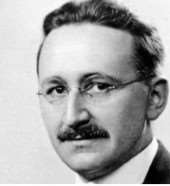 The mainstream in contemporary “macroeconomic” theory is defined by a particular sort of model, “dynamic stochastic general equilibrium” (DSGE).
The mainstream in contemporary “macroeconomic” theory is defined by a particular sort of model, “dynamic stochastic general equilibrium” (DSGE).
Such a model aims at a general equilibrium to the extent that it acknowledges that everything in the system depends on everything else. It is dynamic to the extent that it sees equilibrium not as a static fact, but as an always-vanishing goal, rather like the pseudo-rabbit used to get hounds to race each other around a track. It is stochastic in that it makes use of the randomness-friendly branch of calculus that goes by that name.
Now, although “mainstream macro-economics” and “Austrian economics” are often considered sworn enemies, there is a puzzle as to why, or rather whether it must be so. In particular, the work of one renowned Austrian, Friedrich Hayek, the Nobel Prize winner pictured here, seems very close in spirit to the work of such DSGE pioneers as Finn Kydland and Edward Prescott (also Nobelists).
Valuing a Tradition
In a recent working paper Lawrence H. White, of George Mason University, considers the mainstream/Austrian relationship through a Hayekian lens. White, it should be said, does not identify as an Austrian, but he has described himself as an “economist who values the Austrian tradition.”
White observes that as early as 1928 Hayek was explicitly concerned with the general interdependence of markets. He was a general equilibrium theorist of a sort, but he expressed concern that the “cyclical phenomena” economists observe in trade and credit seem worrisomely in tension with “the system of economic equilibrium theory.”
Hayek’s own greatest subsequent influence was on the first horn of this dilemma, the theory of the trade cycle. The official citation of his 1974 Nobel Prize praised first his “pioneering work in the theory of economic fluctuations.”
Hayek sought to reconcile the two horns through the notion of monetary shocks. Artificially low interest rates cause malinvestment, and that in time must cause a contraction.
Yet that gets us back to the contemporary schism between mainstream and Austria, because these fluctuations are not a central concern of DSGE, certainly not of the DSGE of the Kydland/Prescott variety. To the extent that it does look at the business cycle, it rejects a monetary-shock-based explanation in favor of supply or technology shocks. White stresses that in many “neoclassical DSGE models no variable for the money stock appears in the equation system,” a situation that has chased away once powerful “Hayekian memes.”
At the Edge of a Stream
White suggests that we can find Hayek’s continuing influence, but to do so we have to look away from the center of the mainstream toward its periphery – toward the stream’s banks, in a somewhat punning twin sense. Claudio Borio, William R. White, and others have written “a large set of thoughtful essays emphasizing the dangers of credit and asset-price booms” in true Hayekian fashion. Who are they? Borio is head of the Monetary and Economic Department of the Bank for International settlements. White was formerly at the BIS, but is now at the Organization for Economic Cooperation and Development.
Another contemporary thinker, Guillermo A. Calvo, has written an article with the pertinent subtitle, “The Austrian School of the trade Cycle was on the Right Track.”
So … who is Calvo? Among much else, he is the former chief economist with the Inter-American Development Bank. One might say – though White doesn’t quite say it – that the institutions of international central banking are generating their own critics from within, critics of the institution of central banking and its cyclical consequences, and that these critics naturally turn back to Hayek, even at the expense of putting themselves on the periphery of the theoretical consensus.
One of the major themes in Calvo’s work of late has been his discussion of the reasons why people value fiat money, that is, the stuff elevated to the status of money by the sayso of sovereigns (or, in the case of the euro) by the sayso of a collection of sovereigns. People value fiat money despite their sensible concern about their own savings, because and to the extent that both prices and wages tend to be sticky. This stickiness in turn is critical to Calvo’s discussion of how the works get gummed up, that is, to his understanding of the boom-bust cycle.
Borio, similarly, has called for macro theories that will “capture more deeply the monetary nature of our economies: the banking sector does not just allocate given resources by creates purchasing power out of thin air.”
With such voices, with their experience inside the belly of the beast, speaking up, it remains plausible to hope that the estrangement between Austrians and the mainstream will yet prove temporary.



